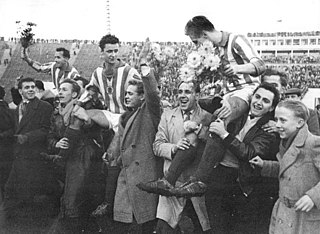
The DDR-Liga was, prior to German reunification in 1990, the second level of football competition in the DDR, being roughly equivalent to the 2. Bundesliga in West Germany.
The 1949–50 DDR-Oberliga, playing as the DS-Liga in its first season as the DDR, the German Democratic Republic was only formed after the start of the season, was the inaugural season of the DDR-Oberliga, the first tier of league football in East Germany.
The 1950–51 DDR-Oberliga was the second season of the DDR-Oberliga, the first tier of league football in East Germany.

The 1951–52 DDR-Oberliga was the third season of the DDR-Oberliga, the first tier of league football in East Germany.
The 1952–53 DDR-Oberliga was the fourth season of the DDR-Oberliga, the first tier of league football in East Germany.
The 1953–54 DDR-Oberliga was the fifth season of the DDR-Oberliga, the first tier of league football in East Germany.

The 1954–55 DDR-Oberliga was the sixth season of the DDR-Oberliga, the first tier of league football in East Germany. After the 1954–55 season the league played a transition round in autumn 1955, followed by five seasons, until 1960, where it played in the calendar year format. From 1961–62 onwards the league returned to its traditional format.
The 1955 DDR-Oberliga was the seventh season of the DDR-Oberliga, the first tier of league football in East Germany. After the 1954–55 season the league played a transition round in autumn 1955, followed by five seasons, until 1960, where it played in the calendar year format. From 1961–62 onwards the league returned to its traditional format.

The 1956 DDR-Oberliga was the eighth season of the DDR-Oberliga, the first tier of league football in East Germany. Rather than in the traditional autumn-spring format the Oberliga played for six seasons from 1955 to 1960 in the calendar year format, modelled on the system used in the Soviet Union. From 1961–62 onwards the league returned to its traditional format.
The 1957 DDR-Oberliga was the ninth season of the DDR-Oberliga, the first tier of league football in East Germany. Rather than in the traditional autumn-spring format the Oberliga played for six seasons from 1955 to 1960 in the calendar year format, modelled on the system used in the Soviet Union. From 1961–62 onwards the league returned to its traditional format.
The 1958 DDR-Oberliga was the tenth season of the DDR-Oberliga, the first tier of league football in East Germany. Rather than in the traditional autumn-spring format the Oberliga played for six seasons from 1955 to 1960 in the calendar year format, modelled on the system used in the Soviet Union. From 1961–62 onwards the league returned to its traditional format.

The 1959 DDR-Oberliga was the eleventh season of the DDR-Oberliga, the first tier of league football in East Germany. Rather than in the traditional autumn-spring format the Oberliga played for six seasons from 1955 to 1960 in the calendar year format, modelled on the system used in the Soviet Union. From 1961–62 onwards the league returned to its traditional format.

The 1960 DDR-Oberliga was the twelfth season of the DDR-Oberliga, the first tier of league football in East Germany. It was the last season not to be played in the traditional autumn-spring format, with the Oberliga having played for six seasons from 1955 to 1960 in the calendar year format instead, modelled on the system used in the Soviet Union. From 1961–62 onwards the league returned to its traditional format.
The 1961–62 DDR-Oberliga was the 13th season of the DDR-Oberliga, the first tier of league football in East Germany. It was the first season played in the traditional autumn-spring format again after the Oberliga had played for six seasons from 1955 to 1960 in the calendar year format instead, modelled on the system used in the Soviet Union. The league was played as a triple round with a home-and-away round and an additional round of games at neutral venues to allow for an earlier start.
The 1962–63 DDR-Oberliga was the 14th season of the DDR-Oberliga, the first tier of league football in East Germany.
The 1964–65 DDR-Oberliga was the 16th season of the DDR-Oberliga, the first tier of league football in East Germany.
The 1968–69 DDR-Oberliga was the 20th season of the DDR-Oberliga, the first tier of league football in East Germany.
The 1969–70 DDR-Oberliga was the 21st season of the DDR-Oberliga, the first tier of league football in East Germany.
The 1989–90 DDR-Oberliga was the 41st season of the DDR-Oberliga, the first tier of league football in East Germany. It was the last season of the league under the name of DDR-Oberliga as it played as the NOFV-Oberliga in the following season. East Germany saw great political change during the 1989–90 season with the opening of borders in October 1989, free elections in March 1990 and the eventual German reunification later in the year.







